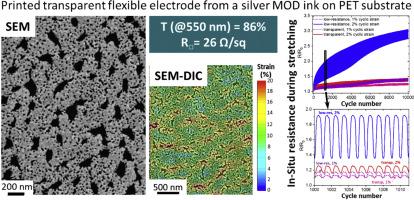基于无颗粒银墨水的纳米多孔柔性透明电极的变形机理
IF 2.9
Q2 MATERIALS SCIENCE, MULTIDISCIPLINARY
引用次数: 0
摘要
在这项工作中,我们探索了基于PET基板上金属有机分解(MOD)银油墨的透明电极的形态,变形行为和功能之间的关系。自组织的纳米孔微观结构具有良好的银韧带互连性,可以提供必要的光学透明度和足够的电导率。现场电阻测量的拉伸测试显示,随着施加应变的增加,电阻适度增加,表明涂层适用于柔性电子应用。原位扫描电镜结合数字图像相关分析表明,拉伸试验过程中产生的裂纹是短而孤立的,这有利于在单调和循环加载过程中保持良好的机电稳定性。与合成纳米多孔超薄膜的其他方法相比,所展示的透明电极是在非常低的无颗粒MOD油墨消耗下通过单次印刷固化工艺制备的,因此适合于具有成本效益的大规模生产。本文章由计算机程序翻译,如有差异,请以英文原文为准。

Deformation mechanisms of nanoporous flexible transparent electrodes based on particle-free silver inks
In this work, we explore the relationships between the morphology, deformation behavior, and functionality of transparent electrodes based on metal-organic decomposition (MOD) silver inks on PET substrates. A self-organized nanoporous microstructure with good interconnectivity of silver ligaments is shown to provide the necessary optical transparency and sufficient conductivity of the electrode. Tensile tests with in-situ resistance measurements revealed moderate resistance increase with increasing applied strain, indicating the suitability of the coatings for flexible electronics applications. With the help of in-situ scanning electron microscopy in combination with digital image correlation, it is demonstrated that cracks which are generated during a tensile test are short and isolated, which is beneficial for good electromechanical stability during monotonic and cyclic loading. In contrast to alternative methods for synthesis of nanoporous ultrathin films, the demonstrated transparent electrode is fabricated by a single printing-curing process under very low consumption of particle-free MOD ink, thus being suitable for cost-effective mass production.
求助全文
通过发布文献求助,成功后即可免费获取论文全文。
去求助
来源期刊

Materialia
MATERIALS SCIENCE, MULTIDISCIPLINARY-
CiteScore
6.40
自引率
2.90%
发文量
345
审稿时长
36 days
期刊介绍:
Materialia is a multidisciplinary journal of materials science and engineering that publishes original peer-reviewed research articles. Articles in Materialia advance the understanding of the relationship between processing, structure, property, and function of materials.
Materialia publishes full-length research articles, review articles, and letters (short communications). In addition to receiving direct submissions, Materialia also accepts transfers from Acta Materialia, Inc. partner journals. Materialia offers authors the choice to publish on an open access model (with author fee), or on a subscription model (with no author fee).
 求助内容:
求助内容: 应助结果提醒方式:
应助结果提醒方式:


